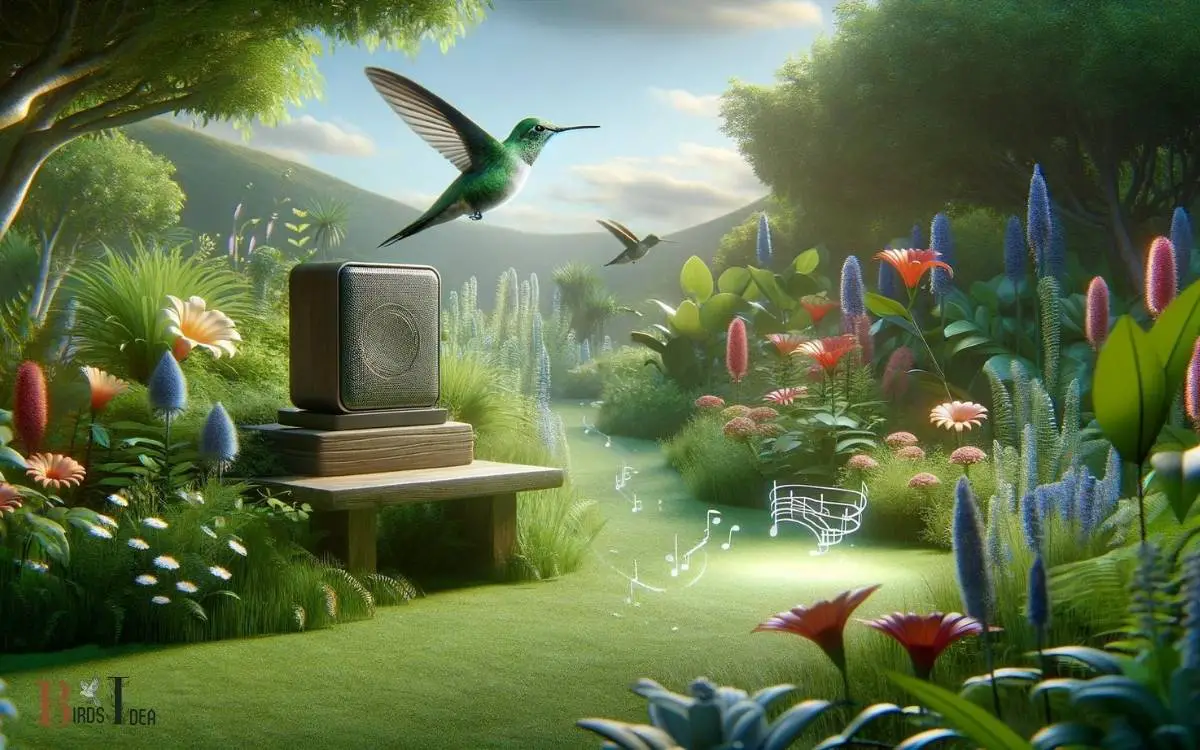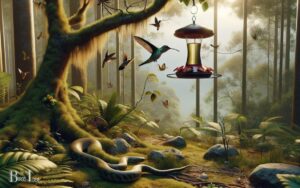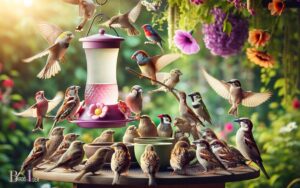Hummingbird Sounds to Attract Them: Chirps, Trills, Whistles
To attract hummingbirds using sound, replicate their natural vocalizations and introduce harmonious tones into your garden. Sounds like chirps, trills, whistles, and buzzes can create an inviting atmosphere for these birds.
Hummingbirds communicate and interact with their environment through specific sounds.
By emulating these sounds, you can create an appealing auditory environment:
Entice hummingbirds with authentic sounds, transforming your garden into a symphony of nature’s music.

Key Takeaway
4 Sound Type to Attract Hummingbird
| Sound Type | Description | Purpose |
|---|---|---|
| Chirping | Soft, high-pitched communication sounds | Attracts attention, mimics natural communication |
| Trilling | Rapid, repetitive call-like sounds | Signals territory, attracts mates |
| Whistling | Clear, melodious tones | Captures interest, resembles natural sounds |
| Buzzing | Imitates wing flapping noise | Indicates presence of mates or rivals, simulates natural environment |
Understanding Hummingbird Vocalizations
One key way to understand hummingbird vocalizations is by recognizing the variety of sounds they produce. Hummingbirds produce a wide range of vocalizations, including chirps, squeaks, and whistles.
These sounds serve various purposes, from communication to courtship displays. Scientists have observed that different species of hummingbirds produce distinct vocalizations, which are used for territorial defense and mate attraction.
By closely studying these vocalizations, researchers have been able to gain insight into the behavior and social dynamics of hummingbird populations.
Additionally, understanding the nuances of hummingbird vocalizations can provide valuable information about their ecology and distribution.
This knowledge can aid conservation efforts and contribute to the overall understanding of these fascinating creatures.
Identifying Attractive Pitch and Frequencies
A variety of sounds, including chirps, squeaks, and whistles, are produced by hummingbirds, with each species emitting distinct vocalizations used for territorial defense and mate attraction.
Identifying attractive pitch and frequencies in hummingbird vocalizations is vital for understanding their mating behaviors. Different species have specific pitch and frequency ranges that are more attractive to potential mates.
The table below illustrates the pitch and frequency ranges of vocalizations for three common hummingbird species:
| Hummingbird Species | Attractive Pitch Range | Attractive Frequency Range |
|---|---|---|
| Ruby-throated | High | 2.5-5 kHz |
| Anna’s | Medium | 1.6-3.5 kHz |
| Broad-tailed | Low | 1-2.5 kHz |
Understanding these pitch and frequency ranges can aid in creating artificial sounds to attract hummingbirds for research or conservation purposes.
Mimicking Natural Sounds in Your Garden
Mimicking natural sounds in a garden can attract hummingbirds and enhance the overall biodiversity of the area.
To effectively mimic natural sounds and create a hospitable environment for hummingbirds, consider the following:
- Water Features: Incorporating a small pond or fountain can replicate the soothing sound of running water, which hummingbirds are naturally drawn to.
- Native Plantings: Utilizing native plants that produce natural sounds such as rustling leaves or seeds rattling in the wind can create an environment that mimics the sounds of a hummingbird’s natural habitat.
- Wind Chimes: Installing wind chimes can add gentle, melodic sounds to your garden, attracting hummingbirds while also providing a peaceful ambiance for human enjoyment.
Incorporating Chirping and Trilling Techniques
To further enhance the garden’s appeal to hummingbirds, gardeners can incorporate chirping and trilling techniques, drawing on the natural sounds of these birds’ habitats. Chirping involves producing short, high-pitched sounds, often with a rapid, staccato quality.
Gardeners can mimic these sounds using various tools or even by whistling softly. Trilling, on the other hand, involves producing a rapid succession of musical notes, resembling the sound of a bird’s song.
This can be achieved through the use of wind chimes or other musical instruments that create a melodic, cascading effect.
By incorporating these techniques into the garden, the environment becomes even more enticing to hummingbirds, as it closely resembles their natural auditory surroundings, increasing the likelihood of attracting these beautiful creatures.
Utilizing Whistle and Buzzing Sounds
The gardeners can also enhance the garden’s appeal to hummingbirds by utilizing whistle and buzzing sounds, adding to the natural sounds of the birds’ habitats and attracting them to the environment.
Whistle Sounds:
Mimicking the high-pitched, melodious sounds of insects and birds, gardeners can use whistles to create an inviting environment for hummingbirds. These sounds can replicate the calls of potential mates or the presence of abundant nectar sources, both of which attract hummingbirds.
Buzzing Sounds:
Simulating the buzzing of insects, such as bees and flies, can also be effective in luring hummingbirds. The rapid, vibrating noises produced by buzzing sounds can signal the presence of food sources, making the garden more appealing to these birds.
Balancing Sound Levels:
It’s essential to maintain a balance between natural and artificial sounds to avoid overwhelming the birds with excessive noise, ensuring a harmonious audio environment for the hummingbirds.
Creating a Harmonious Audio Environment
To create a harmonious audio environment to attract hummingbirds, one must harmonize with natural sounds and utilize specific birdcalls.
Understanding the natural sounds present in the environment and incorporating them into the audio setup can help create a familiar and inviting atmosphere for hummingbirds.
Additionally, using specific birdcalls that are known to attract hummingbirds can further enhance the auditory appeal of the environment.
Harmonizing With Natural Sounds
When harmonizing with natural sounds, individuals can create a more inviting audio environment for hummingbirds by integrating soothing and familiar auditory elements.
This can be achieved by:
- Incorporating gentle water sounds: The sound of a gentle stream or waterfall can create a calming atmosphere for hummingbirds, mimicking their natural habitat and making them feel more at ease.
- Adding bird calls: Playing recordings of soft bird calls can help attract hummingbirds by signaling the presence of other birds and creating a familiar and safe environment.
- Using wind chimes: The gentle, melodic sounds of wind chimes can create a peaceful and harmonious audio backdrop, which can be appealing to hummingbirds as they forage and rest.
Utilizing Specific Birdcalls
Utilizing specific birdcalls can enhance the audio environment to attract hummingbirds, creating a harmonious atmosphere in outdoor spaces.
Certain birdcalls, such as the high-pitched trills and chirps of the black-chinned hummingbird or the distinct chattering of the ruby-throated hummingbird, can signal the presence of a suitable feeding area to other hummingbirds in the vicinity.
By strategically incorporating these birdcalls into the outdoor audio environment, individuals can effectively attract hummingbirds to their gardens or outdoor spaces.
These specific calls not only serve as auditory cues for hummingbirds but also contribute to the overall natural soundscape, promoting a sense of tranquility and natural balance.
Understanding the nuances of each species’ vocalizations and incorporating them into the environment can significantly increase the chances of attracting hummingbirds.
Implementing Sound-Based Attractants
Sound-based attractants can be implemented using recordings of specific hummingbird vocalizations.
To effectively utilize sound-based attractants, individuals can follow these steps:
- Select the Right Sounds: Choose recordings of hummingbird vocalizations that are native to the area where the attractants will be used.
- Use High-Quality Speakers: Invest in speakers that can accurately reproduce the intricate sounds of hummingbirds to ensure the attractants are effective.
- Consider Timing: Play the recordings during the times of day when hummingbird activity is at its peak, such as early morning or late afternoon.
Implementing sound-based attractants requires careful consideration of the sounds used, the equipment utilized, and the timing of play. By following these steps, individuals can increase the likelihood of attracting hummingbirds to their desired location.
Enhancing Your Garden With Hummingbird-Friendly Tunes
Enhancing your garden with hummingbird-friendly tunes involves selecting and playing recordings of hummingbird vocalizations that match the area’s native species.
By playing these tunes, you can create an inviting environment for hummingbirds, encouraging them to visit and potentially even nest in your garden.
Below is a table listing some common hummingbird species and their vocalizations to help you choose the right tunes for your garden:
| Hummingbird Species | Vocalization Description | Example Recording |
|---|---|---|
| Ruby-throated | Sharp, metallic “chip” notes during flight | link_to_example_recording_ruby_throated |
| Anna’s | High, buzzy “chee-chee-chee” calls | link_to_example_recording_annas |
| Rufous | Chattering and trilling sounds | link_to_example_recording_rufous |
Selecting the right tunes that match the vocalizations of the hummingbird species in your area can significantly enhance your garden’s appeal to these delightful creatures.
Conclusion
By understanding and replicating hummingbird vocalizations, one can create a symphony of attractive sounds in their garden.
Mimicking natural sounds such as chirping, trilling, whistling, and buzzing can help enhance the audio environment and attract these beautiful creatures.
By incorporating sound-based attractants and hummingbird-friendly tunes, one can create a captivating auditory landscape that beckons the presence of these delicate and graceful birds.






